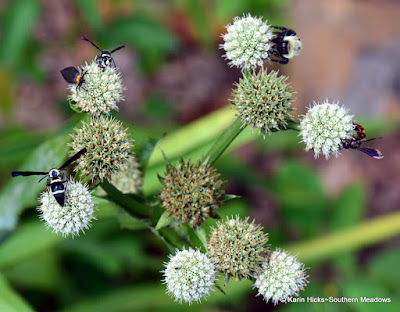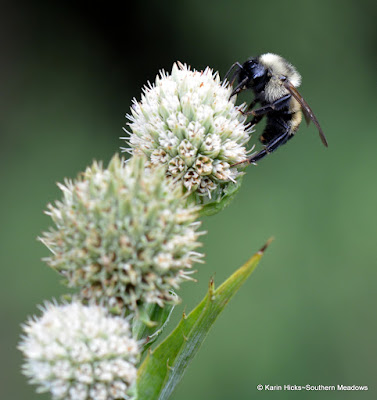Have you noticed how some plants really have it going on? It's pretty evident that not all plants are created equally, especially when it comes to servicing pollinators. Observing the insects flying around our garden they definitely have their favorites. Conversely, not all insects are effective pollinators.
 |
| Pollinators on Aralia spinosa |
Earlier this summer if you were a pollinator in our garden the Button Bush (
Cephalanthus occidentalis) was the place to be. If you are not familiar with this terrific plant you can read more about it
here. In bloom now are two other natives that are all the buzz in our garden, Devil's Walking Stick (
Aralia spinosa) and Rattlesnake Master (
Eryngium yuccifolium). These two fabulous plants have the misfortune of having unbecoming common names; fortunately, however, pollinators aren't intimidated.
 |
| Pollinators on Eryngium yuccifolium |
Have you ever taken the time to really observe the blooms in your garden through the seasons. In our garden some blooms are shrouded in pollinators while others are ostensibly barren. Why are some flowers seemingly more attractive than others?
 |
| Spicebush Swallowtail on Devils Walking Stick |
Plants have developed a partnership with pollinators to ensure cross-pollination. Blooms have a certain shape, color, smell or bloom time which provide signs to pollinators to stop by and visit. Insects, on the other hand, have a vested interest in visiting flowers; to gather nectar and/or pollen and they have special tools to do so. It is a mutually beneficial relationship. But now this begs the question, what are pollinators looking for in a flower?
 |
| Gray hairstreak butterfly on rattlesnake mater |
Some blooms are only serviced by a specific pollinator such as a moth, beetle, fly or solitary bee. These flowers have a distinguishing feature(s) to attract that pollinator and exclude other would-be pollinators. The pollinator too has a certain characteristic(s) which allows it to reach the nectar and/or pollen. So how do flowers appeal to different kinds of insects?
Scent~Some plants produce a fragrance to lure visitors. Bees, moths, flies beetles and bats all have a good sense of smell. Moths are attracted to blooms that have a strong sweet perfume that advertises to them in the darkness. Flies, ants and beetles on the other hand are attracted to strong unpleasant odors that resemble rotting flesh.
Time of Day~ Plants open their blooms to make themselves available to their most effective
pollinator. Flower pollination can take place during the day, evening or night time from insects that are day, diurnal, crepuscular or nocturnal. Moths and bats drop in on flowers that open in the evening and night time hours while bees, wasps, flies, butterflies and hummingbirds are daylight flying.
Color~Bees don't see the color red instead they base their color vision on UV blue, green and yellow. Flowers trying to attract bees often have UV patterns on their petals to guide the bees onto the flower landing platform and then into the flower. This is why you will sometimes see bees on red blooms. Butterflies have good vision and visit brightly colored blooms. Hummingbirds are particularly attracted to red and other vibrant colors while moths and bats prefer blooms that are pale in color which are visible on a moonlit night.
Shape~Flower pollination is aided by the shape of the bloom. Open, bowl shaped flowers are especially used by honeybees, bumblebees and some solitary bees that run around the inside of the flower in a circle to collect pollen. Flat, open flowers like members of the Asteraceae family cater to different types of insects including butterflies, bees and beetles. Tubular flowers are especially attractive to hummingbirds and long tongued insects that can reach deep into the back of the flower for the nectar. Bunched flowers such as members of the carrot family (Apiaceae) are attractive to butterflies, bees, wasps and hoverflies.
On the flipside, flowers exploit insects to achieve pollination and ultimately their survival. What characteristics make certain insects more effective pollinators to particular plants or plant families?
Butterflies and Moths (Lepidoptera)~ ingest nectar through their long, very thin proboscis. They take nectar from small tubular flowers and flowers with small tubular florets grouped together in larger inflorescences. It should be noted that some moths don't have mouths and therefore don't eat as adults. Most people are familiar with diurnal moths which are members of the Sphingidae family commonly known as hawk moths, sphinx moths or hornworm moths.
 |
| Scape moth (Ctenucha fulvicollis) |
Flies (Diptera) are pollinators too! Hoverflies (Syrphidae) and Bee Flies (Bombylius) are two flies that frequently visit flowers. Hoverflies mimic bees or wasps but do not sting or bite. Syrphid flies tend to visit small, flat flowers which present nectar openly. They are flower specialists consuming nectar and pollen. Bee flies mimic bumblebees and have a long proboscis (like Lepidoptera) which is used to drink nectar. Unlike bees they hover in front of flowers.
 |
| Syrphid fly |
Beetles (Coleoptera) are the biggest group of pollinators by sheer numbers although they are not always the most effective pollinators. The long-horned beetle and flower beetles are two species of beetles that are often found on flowers. Beetles are especially important to plants such as magnolias, sweet shrubs and spicebush. Lady beetles are often seen on flowers but they are mainly going after other insects such as aphids.
 |
| Trigonopeltastes delta flower beetle |
Bees and Wasps (Hymenoptera) are both seen at flowers. Bees however, are very dependent on flowers to provide both pollen and nectar for their larvae. Wasps, on the other hand, provide spiders and other insects to their larvae and only feed on nectar as adults. Bees have tongues which they use to collect nectar and store in an internal chamber (honey stomach) and when they return to their nesting site they regurgitate the nectar.The length of their tongue determines which shape and size flower they visit. Some species of bees such as leafcutter bees and mason bees collect pollen on a hairy area under their abdomen (pollen brush). Mason bees are excellent pollinators of fruit trees and bushes. Like bees, most wasps are solitary and live in specialized habitats. They have short tongues and are attracted to flowers with sweet liquids (think rotting fruit or jam). This is why you see them immersing their head deep into blooms.

So, not all plants are equal. Each plant and pollinator has a specific survival strategy. Is it better to be a generalist or a specialist? Being a specialists can be problematic if the plant or insect that are codependent disappear from the habitat putting the species in jeopardy. Likewise, as a generalist the risk is that cross-pollination doesn't occur because the insect flies off to visit a different type of flower. There is an amazing interdependence between insects and flowers. Both the Rattlesnake Master and Devil's Walking stick get gold medals when it comes to attracting an array of insects. However, there is no one size fits all plant and this is why it is essential to offer a variety of florae that will appeal to a multiplicity of pollinators and protect biodiversity so that all these creatures can continue to play a role in the great web of life in the garden.













.png)
